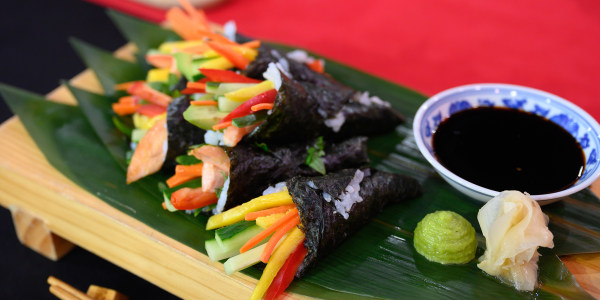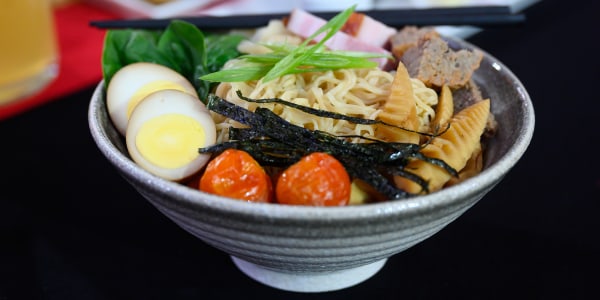Ramen master Ivan Orkin of Ivan Ramen in New York City is joining TODAY to share his top tips for hosting DIY temaki sushi and ramen parties. He showcases delicious recipes from his new cookbook, "The Gaijin Cookbook: Japanese Recipes from a Chef, Father, Eater, and Lifelong Outsider," including how to make perfect sushi rice, miso-glazed salmon and seasoned ground chicken.
TODAY has affiliate relationships, so we may get a small share of the revenue from your purchases. Items are sold by the retailer, not by TODAY.
How to roll sushi for a temaki party

Temaki sushi (aka hand rolls) are hugely popular with my kids, partly because they all love sushi, but also because it allows them to get creative with fillings and eat with their hands. Every few months, we'll throw a temaki party. Everyone gets a bowl of rice and a stack of nori, then we all go to town making our own rolls filled with ingredients arranged in the center of the table. This works equally well as a dinner party for adults.
Sushi parties are great because most of the work consists of shopping, prep and setting the table. Granted, a temaki party is easier to pull off in a country like Japan where you can find sushi-grade fish in practically any market, but it's totally possible in the U.S. if you have access to a Japanese market or a reputable place to buy fresh fish. If your local fish selection is really slim, don't fret, you can always supplement with cooked items like pork belly and salmon, plus vegetables like avocado and cucumber.
There is no set path to success here, it's a truly forgiving way of hosting a dinner party. Nevertheless, here's a rundown of three basic components needed for any temaki party (the rice, the nori and the fillings), plus how to put it all together.
Rice
Properly cooked and seasoned rice is an under-appreciated component of sushi in the U.S. That being said, on most nights when we host a temaki party, I go the easy route and serve unseasoned short-grain rice that's been cooked in a rice cooker ... and it works really well.
But if you're making rice at home, why not do it right? The very best sushi chefs I've encountered in Japan are fastidious about the type of rice they use. I season mine very simply, but it makes all the difference in the final dish.
Nori
It's honestly very difficult to tell the difference between various brands of nori from the packages. Eventually, you'll find a kind you like, but it may take some trial and error to land on one that's aromatic and crisp, rather than lifeless and papery. If your options are limited, just buy what you can find.
If you're working with whole sheets of nori, cut each piece into quarters and give each person about 10 squares to start. If you're so inclined, you can toast each sheet of nori before slicing it by waving it over an open flame for 10 to 15 seconds. Don't get too close or linger too long over the flame, or the nori will shrivel and burn. But don't be too shy, as the seaweed won't pick up any toasty flavor.
Fillings
Provide your guests with a nice mix of cooked and raw protein, plus plenty of fresh herbs and veggies. It doesn't take much to make a nice spread, but you want to have enough of each filling so that everyone can have a taste. As for what to buy, the world is your oyster. Pick whatever you and your family like.
Cooked Items
Choose one or two of the following dishes and serve them warm or at room temperature: kimchi pork belly, miso-glazed salmon or seasoned ground chicken.
The beauty of this dish is in its simplicity. It only has five ingredients, but each plays a vital part in the recipe. The miso adds flavor, the sake and mirin season the fish, and the mayo promotes the development of a nicely browned finish on the salmon.
This easy-to-make chicken dish comes together in minutes and it's incredibly versatile. It's prefect served over rice, rolled in sushi, sprinkled over ramen or stuffed in lettuce cups.
Condiments
Here's your chance to bust out the nice shoyu. Don't sully your high-quality fish with crappy soy sauce; find an artisanal brand you like. As for wasabi, if you have access to fresh roots, that's fantastic. If not, the squeezable paste that comes in a tube will be fine.
Assemble the table
Provide each of your guests with a bowl of rice, a stack of nori and a little ramekin of soy sauce. Set the bowls and plates of fillings in the middle of the table for everyone to share. There's no wrong way to make temaki, but here's the gist of it: Hold a square of nori in one hand and spread a small scoop of rice on top. Smear a little wasabi on the rice, then lay the fillings in a line down the center. Try not to pack the roll so full that fish and rice will spill out the sides. Roll it up like a taco, give it a light dip in soy sauce and enjoy.
How to throw an instant ramen party
It took a lot of trials — and a healthy amount of error — for me to cook a bowl of ramen I was proud to serve at my restaurants. Nowadays at Ivan Ramen, the simplest bowl of shio ramen contains no fewer than 10 different components. And they're all made from scratch with very specific ingredients.
But that's not what this party is about. This setup is for people who can't dedicate a whole weekend to making their own noodles, or for those who live in a place where fresh ramen noodles are hard to come by. Rather than making a big project out of ramen, we're gussying up instant noodles.
In Japan there are countless brands of instant ramen. (In fact, when I was running my shops in Tokyo, I had my own brand of instant ramen that sold out every year.) In Japan, instant ramen occupies basically the same function as it does here: a quick, dirt-cheap meal. At any convenience store, you can pick up a couple packages of noodles and a few fresh ingredients from the refrigerated section to make yourself an eminently slurp-able bowl of noodles. It's in that spirit that we present the instant ramen party. The idea is to serve your guests instant ramen in a fresh soup, with whatever upgraded toppings and seasonings you feel like throwing together.
Kids like it because they get to customize their own bowls. It's fun for a dinner party, too, especially if you ask everyone to bring their favorite brand of instant ramen to the party. But the true beauty of this approach is that your guests can be as reckless as they want. Want your ramen super spicy? Add a fat scoop of chunky chili oil. Prefer your noodles dry? Use less broth and lots of toppings. Like eggs? Add two. Or three. Nobody's judging here.
Soup
Make sure to have enough broth for 1 cup of dashi plus 1 cup of chicken stock per guest. Always have extra on hand, just in case some people want seconds.
Seasonings
As a guideline, you only want to add 1/2 to 2 teaspoons of any of the following items per 2 cups of soup:
- Miso (any type of your choice)
- Katsuobushi (bonito flakes ground to a fine powder in a spice grinder)
- Soy sauce
- Brine from pickled garlic
- Ginger-onion shio tare
- Rendered pork or chicken fat
- Toasted sesame oil
- Japanese chili oil (rayu)
- Chunky chili oil
Noodles
Look for packs of instant ramen where the noodles and seasonings are kept separate, not the Styrofoam cups of premixed noodles with freeze-dried vegetable bits and seasoning. Budget one to two packages of instant ramen noodles per diner.
Toppings
Choose as many as you like. This is a great place to use up leftovers. You can serve things straight out of the fridge — the broth should be served hot enough to warm everything through. Some of my favorite toppings to set out are slow-roasted tomatoes, seasoned ground pork, simmered bamboo tips, kimchi pork belly, pan-fried pork cutlets in ginger sauce, chicken meatballs and seasoned spinach.
Garnishes
A good garnish should add a pop of color, flavorful finish and/or textural contrast to the dish. Stick with these classics and you can't go wrong: hot-spring eggs (onsen tamago), soy-marinated eggs (ajitama), pickled garlic, thinly sliced Japanese green onions (or scallions) and thinly sliced nori sheets.
Assemble the ramen bowls
- Bring 12 cups of water to a boil in a large pot and season liberally with salt. Have a strainer standing by for cooking and draining the noodles.
- Measure out the dashi and chicken broth — 1 cup of each per serving. Combine both liquids in a large saucepan and bring to a simmer over medium-high heat, then drop the heat to very low and keep covered.
- Instruct your diners to start by adding their choice of seasonings to their own empty soup bowls. They should feel free to mix and match as they like, but be wary of salt levels: The seasoning packets that come with instant ramen already contain plenty of salt, sugar, MSG and other seasonings. And don't forget to add a little richness in the form of animal fat, oil or butter.
- Working with one serving at a time, drop the noodles into the boiling water and cook until al dente — usually 2 to 3 minutes, tops. Meanwhile, ladle 2 cups of soup into each guest's bowl and tell them to stir in the seasonings. Drain the noodles thoroughly and add them to the soup. Let your guests top and garnish their individual ramen bowls however they like.



